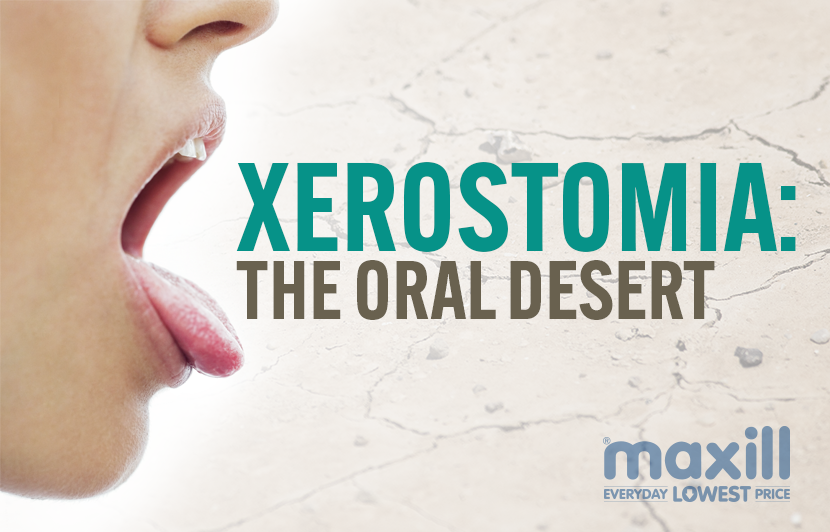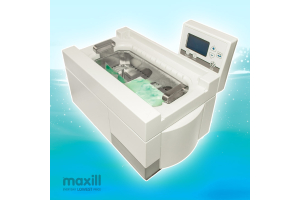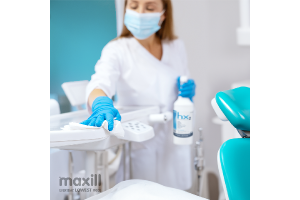Xerostomia: The Oral Desert

Xerostomia, commonly known as dry mouth, occurs when the salivary glands in the mouth do not produce enough saliva to keep the mouth moist. This lack of saliva can lead to discomfort, difficulty speaking and swallowing, and an increased risk of oral health issues such as tooth decay and gum disease. Aging, medications, and medical conditions can also contribute to dry mouth. Assessing the reasons for xerostomia by a thorough medical history and examination will aid us in determining possible interventions to ease and manage the manifestations of the syndrome for our patients.
Function of Saliva
Saliva serves many purposes; it lubricates food and tissues, dilutes and clears sugars, protects tissues, clears dietary acids through swallowing, neutralizes and buffers acids, and balances the demineralization-remineralization process of teeth. It starts the digestive process and helps stabilize, protect, and transport critical nutrients to be absorbed in the GI tract. Reduced salivary flow can cause difficulties in tasting, chewing, swallowing, and speaking; it can also increase the chance of developing dental caries, demineralizing teeth, tooth sensitivity, and oral infections.
Saliva is a mixture of secretions from the significant (i.e., parotid, submandibular, sublingual) and minor salivary glands in the oral mucosa. In healthy individuals, the daily production of saliva ranges typically from 0.5 to 1.5 liters. Saliva is 99% water and less than 1% solids, including several electrolytes and organic components (e.g., immunoglobulins, proteins, enzymes, mucins). In addition to keeping tissues moist and helping to digest food, saliva cleanses the oral cavity, makes it possible to chew and swallow food, facilitates oral sugar clearance, and serves as a buffer that protects oral mucosa against orally ingested acids or regurgitated stomach acid. Salivary proteins and mucins contribute to the lubrication and coating of oral tissues, protecting the mucosa from chemical, microbial, and physical injury (e.g., abrasion). Without adequate salivary flow, tooth decay and various oral infections can develop. Xerostomia symptoms may also worsen at night because salivary flow reaches its lowest levels during sleep, and the problem can be exacerbated by mouth breathing.
Development of Xerostomia
Several factors can contribute to the development of xerostomia, including certain medications, medical conditions such as diabetes, autoimmune diseases and Sjögren's syndrome, dehydration, aging, nerve damage, and chemotherapy or radiation therapy to the head and neck, and other conditions (e.g., uncontrolled diabetes, infections, hormonal changes). Additionally, lifestyle factors such as smoking and excessive alcohol consumption can also lead to dry mouth.
Estimates of xerostomia prevalence in the general population vary widely and are affected by age and health status. Previous studies reported xerostomia prevalence estimates ranging from 10 to 26% in men to 10 to 33% in women. A 2018 systematic review reported an overall estimated prevalence of xerostomia in approximately 22% of the global population. Xerostomia prevalence is generally higher among older individuals, typically due to polypharmacy and the onset of various medical conditions over time. Xerostomia affects an estimated 30% of patients older than 65 years and up to 40% of patients older than 80 years; this is primarily an adverse effect of medication(s), although it can also result from comorbid conditions such as diabetes, Alzheimer's disease, or Parkinson's disease. Xerostomia, while common among older patients, is twice as likely to occur in adult patients who take one or more drugs daily when compared with medication-free individuals.
Xerostomia and Medication
Over-the-counter (OTC) and prescription medications that can contribute to or worsen oral dryness include antihistamines, antihypertensive drugs, decongestants, pain medications, diuretics, muscle relaxants, and antidepressants. The most common types of medications causing salivary dysfunction have anticholinergic effects, e.g., tricyclic antidepressants, antihistamines, antihypertensive medications, and antiseizure/antispasmodic drugs. Dry mouth is also commonly reported as a minor adverse effect of medical cannabis use, along with drowsiness, dizziness, and nausea.
Drug substitutions may help reduce the dry mouth effects of certain medications (e.g., selective serotonin-reuptake inhibitor antidepressants tend to cause less dry mouth than tricyclic antidepressants). A thorough extraoral and intraoral examination to identify the presence or absence of salivary pooling on the floor of the mouth can help a dentist identify who will benefit from further diagnostic evaluations, such as salivary flow rate measurement, minor salivary gland biopsy, or blood and microbial tests.
Patients with complaints of dry mouth should undergo a detailed medical and dental history to help with early detection and identification of potential underlying causes. In patients with xerostomia or salivary gland dysfunction, oral examination may reveal dry and friable oral mucosa, and the tongue may appear dry and fissured. Patients may commonly have dental caries (especially root, cervical, or incisal/cuspal tips), plaque accumulation, gingivitis, and periodontitis. Infections (e.g., oral candidiasis) and enlargement of salivary glands may also be present. Other oral manifestations on examination may include angular cheilitis, mucositis, traumatic oral lesions, dry lips or dry throat, and difficulty wearing/retaining oral prostheses.
Signs and Symptoms of Dry Mouth
-
-
-
- a sticky, dry, or burning feeling in the mouth
- trouble chewing, swallowing, tasting, or speaking
- altered taste or intolerance for spicy, salty, or sour foods or drinks
- a dry or sore throat
- cracked, peeling, atrophic, or sticky lips
- a dry, rough tongue
- mouth sores
- oral fungal infection (e.g., candidiasis)
- hoarseness
- halitosis (bad breath)
- increased risk of dental problems, including caries and periodontal disease
- inability to retain dentures or otherwise poorly fitting removable prostheses
-
-
Managing xerostomia involves addressing the underlying cause of the condition. This may include adjusting medications, treating underlying medical conditions, and making lifestyle changes. In addition, several strategies can help alleviate dry mouth symptoms. These include drinking plenty of water, using artificial saliva products, chewing sugar-free gum, and avoiding caffeine, tobacco, and alcohol.
Individuals experiencing dry mouth need to seek advice from a healthcare professional, such as a dentist or physician, as they can guide them on the most appropriate treatment options. By addressing xerostomia promptly, individuals can reduce the risk of developing oral health issues and improve their overall quality of life.
Maintaining good oral hygiene is also essential for managing xerostomia. Regular dental check-ups and cleanings are necessary to prevent tooth decay and gum disease. Patients with xerostomia should also follow a thorough oral care routine at home, including fluoride toothpaste, soft-bristled toothbrushes, and alcohol-free mouthwash.
Dental and oral health-specific recommendations from the National Institute for Dental and Craniofacial Research and others include the following for patients with dry mouth:
- brush teeth gently at least twice a day with fluoridated toothpaste
- floss teeth every day
- schedule dental visits at least twice a year (with yearly bitewing radiographs)
- use of a prescription-strength fluoride gel (0.4% stannous fluoride, 1.1% sodium fluoride) daily to help prevent dental decay
- prompt treatment of oral fungal or bacterial infections
- application of 0.5% fluoride varnish to teeth
- dental soft- and hard-tissue relines of poorly fitting prostheses and use of denture adhesives
Saliva Stimulants, Substitutes, and Other Strategies
Salivary stimulants should be considered in patients with residual salivary gland function. Non-prescription sugar-free chewing gum, candies, and mints can stimulate salivary output. The FDA has approved prescription salivary stimulants. Examples of medications that promote saliva secretion are pilocarpine (Salagen) and cevimeline hydrochloride (Evoxac capsules) to treat dry mouth.
Over-the-counter saliva substitute products given the ADA Seal of Acceptance for relief of dry mouth means that the product is safe and has shown efficacy in temporarily relieving dry mouth symptoms when used as directed. Saliva substitutes are used as often as needed, and although they do not cure dry mouth, they can temporarily relieve symptoms. They typically contain a combination of carboxymethylcellulose and glycerin to increase viscosity, buffering and flavoring agents (e.g., sorbitol, xylitol), and calcium and phosphate ions. Some products also contain fluoride.
Other strategies and interventions include:
-
-
-
- sipping water or sugarless, caffeine-free drinks
- sucking on ice chips
- using lip lubricants frequently (e.g., every two hours)
- chewing sugar-free gum or sucking on sugar-free candy
- avoiding salty or spicy food or dry, hard-to-chew foods
- avoiding sticky, sugary foods
- avoiding irritants such as alcohol (including alcohol-containing mouth rinses), tobacco, and caffeine
- drinking fluids while eating carefully
- using a humidifier at night
-
-
In conclusion, xerostomia can significantly impact oral health and overall quality of life. By understanding the causes and symptoms of dry mouth and implementing strategies to manage it, patients can alleviate discomfort and reduce the risk of dental problems associated with xerostomia. Seeking guidance from a healthcare professional, such as a dentist or physician, is essential for correctly diagnosing and treating dry mouth.
References
- Xerostomia (dry mouth). American Dental Association. (n.d.). Retrieved April 10, 2024, from https://www.ada.org/resources/ada-library/oral-health-topics/xerostomia











